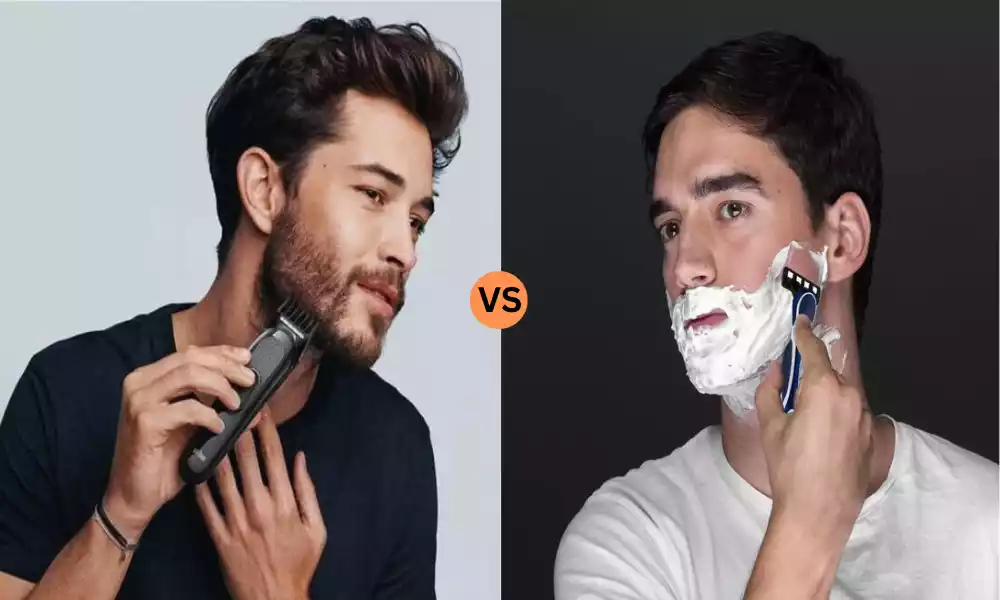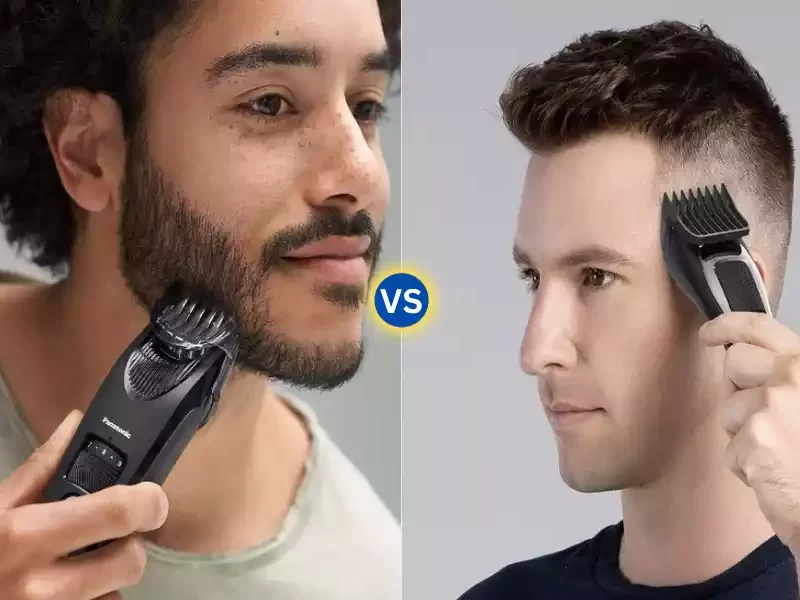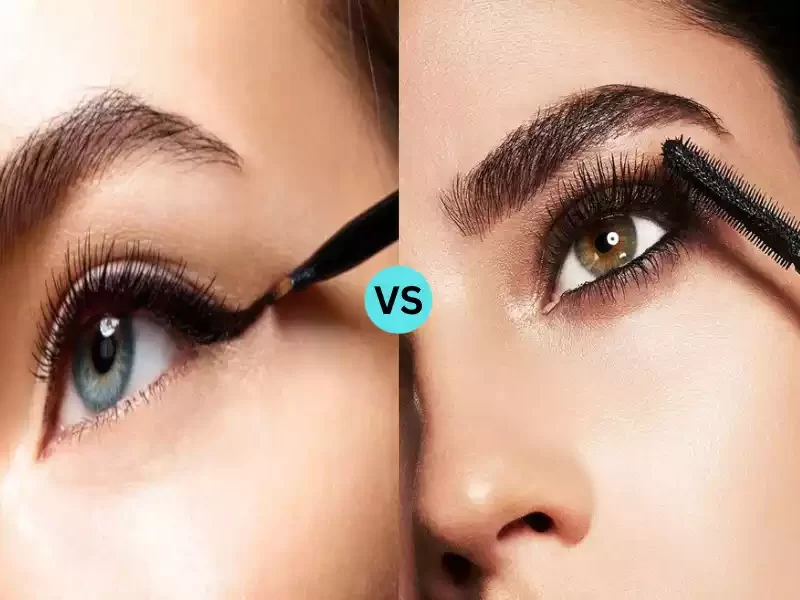Trimmer and Razor are essential grooming tools used for achieving precise hair and beard styles. The trimmer, often electric, is designed with adjustable blades or comb attachments, making it ideal for trimming and shaping facial and body hair to desired lengths without a clean shave. Razors, on the other hand, are sharp-edged tools aimed at providing a smooth, close shave by directly cutting the hair at the skin’s surface. Both tools are integral in personal care routines, ensuring neatness, hygiene, and a polished appearance.
What is a Trimmer?
A Trimmer is a grooming device used to cut, shape, and maintain hair on various parts of the body, including the face, head, and other areas. Typically powered by batteries or mains electricity, trimmers come equipped with adjustable blades or comb attachments that allow users to achieve varying hair lengths. The teeth of the trimmer are designed to cut hair close to the skin, but not as close as a razor, making it ideal for tasks like shaping beards, maintaining stubble, edging sideburns, or trimming body hair. Because of their versatility and precision, trimmers are popular tools among both professional stylists and individuals for at-home grooming.

Structure of Trimmer
A Trimmer is a versatile grooming tool primarily used for trimming and shaping hair. Its structure is designed to ensure precision and safety. Here’s a breakdown of the typical structure of a trimmer:
- Body/Handle: The main part of the trimmer that users grip. It usually houses the motor and the power source (batteries or power connection).
- Power Switch: Most trimmers come with a switch or button to turn the device on or off. Some advanced models may have varying speed settings.
- Blades: The cutting element of the trimmer. These are typically made of stainless steel, titanium, or ceramic and can oscillate or rotate based on the trimmer’s design.
- Adjustable Comb Attachments: These attachments can be fixed onto the trimmer to achieve different hair lengths. They elevate the trimmer blades from the skin by various distances to ensure a specific hair length after trimming.
- Length Settings: Many trimmers have adjustable settings or dials that allow users to set the desired hair length. This changes the distance between the blade and the comb attachment.
- Battery/Power Source: Trimmers can be corded (requiring a direct power connection) or cordless. Cordless trimmers typically use rechargeable batteries, often lithium-ion.
- Charging Port/Socket: For rechargeable trimmers, there is a port or socket where the charger can be plugged in.
- LED Indicator: Some trimmers have LED indicators showing battery life, charging status, or other operational indications.
- Cleaning Brush (Accessory): Many trimmers come with a small brush to help clean hair and debris from the blades.
- Maintenance Accessories: Some trimmers might come with oil or other solutions to maintain blade efficiency and prolong the trimmer’s life.
- Additional Features: Modern trimmers might have waterproof capabilities, quick-charge features, a travel lock, or even self-sharpening blades.
The exact structure and features can vary based on the trimmer’s brand, model, and intended use (like beard trimmers, hair clippers, or body trimmers). Always refer to the trimmer’s manual for specifics about its structure and functionality.
Benefits of Trimmers
Trimmers offer numerous benefits, especially in terms of grooming and maintaining various hair lengths and styles. Here are some of the main benefits of using trimmers:
- Versatility: Trimmers are suitable for a wide range of grooming tasks, from shaping beards and mustaches to maintaining stubble and even trimming body hair.
- Adjustable Lengths: Most trimmers come with adjustable settings or comb attachments, allowing users to achieve different hair lengths easily.
- Reduced Skin Irritation: Since trimmers don’t cut as close to the skin as razors, they often result in less skin irritation, especially for those with sensitive skin.
- Safety: The design of most trimmers, especially those with guard attachments, minimizes the risk of cuts and nicks.
- Cost-effective: While there’s an initial investment, a good-quality trimmer can last for years. This can save money in the long run compared to continually buying disposable razors or cartridges.
- Consistency: Trimmers provide a consistent length and finish, ensuring an even trim throughout the desired area.
- Portability: Many modern trimmers are compact, cordless, and come with a travel pouch, making them convenient for travel.
- Precision: Trimmers are designed for precision, making them ideal for defining edges, sideburns, and intricate beard designs.
- Reduced Razor Bumps: By not cutting as close to the skin as traditional razors, trimmers can help reduce the occurrence of ingrown hairs or razor bumps.
- Multiple Features: Modern trimmers come with various features like waterproof capabilities, quick-charge options, and multiple attachments for different grooming needs.
- Hygiene: Regular trimming, especially in areas like the armpits or the groin, can aid in hygiene by reducing excessive sweat and associated odors.
- Environmentally Friendly: Using a trimmer can be more environmentally friendly than disposable razors, as you’re not regularly discarding plastic or cartridges.
It’s essential to maintain and clean the trimmer regularly to ensure its longevity and effectiveness. With proper care, a trimmer can be a versatile and invaluable grooming tool.
Drawbacks of Trimmers
While trimmers are versatile and convenient grooming tools, they come with their own set of drawbacks:
- Incomplete Close Shave: Trimmers don’t provide as close a shave as razors, which might not be suitable for those seeking a completely smooth finish.
- Maintenance: Trimmers require regular cleaning to remove trapped hair and might also need occasional oiling to ensure the blades function smoothly.
- Battery Dependency: Cordless trimmers rely on batteries, which can run out, necessitating regular charging or battery replacements.
- Initial Cost: High-quality trimmers can be more expensive initially compared to basic razors.
- Learning Curve: Achieving a desired look using a trimmer can take practice, especially for intricate beard styles or even trims.
- Blade Dullness: Over time, the blades of a trimmer can become dull, affecting its performance. Some models might require blade replacements.
- Skin Sensitivity: While less common than with razors, some people might still experience skin irritation or sensitivity from trimmers, especially if pressed hard against the skin.
- Size & Portability: Trimmers are generally bulkier than razors, which might be less convenient for travel or on-the-go grooming.
- Environmental Impact: Electric trimmers have environmental implications related to battery disposal and electronic waste.
- Noise: Electric trimmers produce noise, which might be bothersome to some users or unsuitable for quiet environments.
- Power Issues: For corded trimmers, you’re restricted by the cord length and need for an electrical outlet, which might be inconvenient.
- Durability Concerns: Some cheaper trimmers might not be as durable or long-lasting as higher-quality models or compared to simple razors.
It’s essential to weigh these drawbacks against the benefits and individual preferences when choosing a grooming tool. Proper care and maintenance can mitigate some of these concerns and prolong the life and efficiency of a trimmer.
What is a Razor?
A Razor is a bladed tool primarily used for the removal of unwanted body hair through the act of shaving. The razor’s sharp edge is designed to cut the hair as close to the skin as possible, providing a smooth finish. There are various types of razors, including straight razors, which are a single long blade that folds into a handle; safety razors, which have a protective guard between the blade and the skin to minimize cuts; and cartridge razors, which come with replaceable multi-blade cartridges.
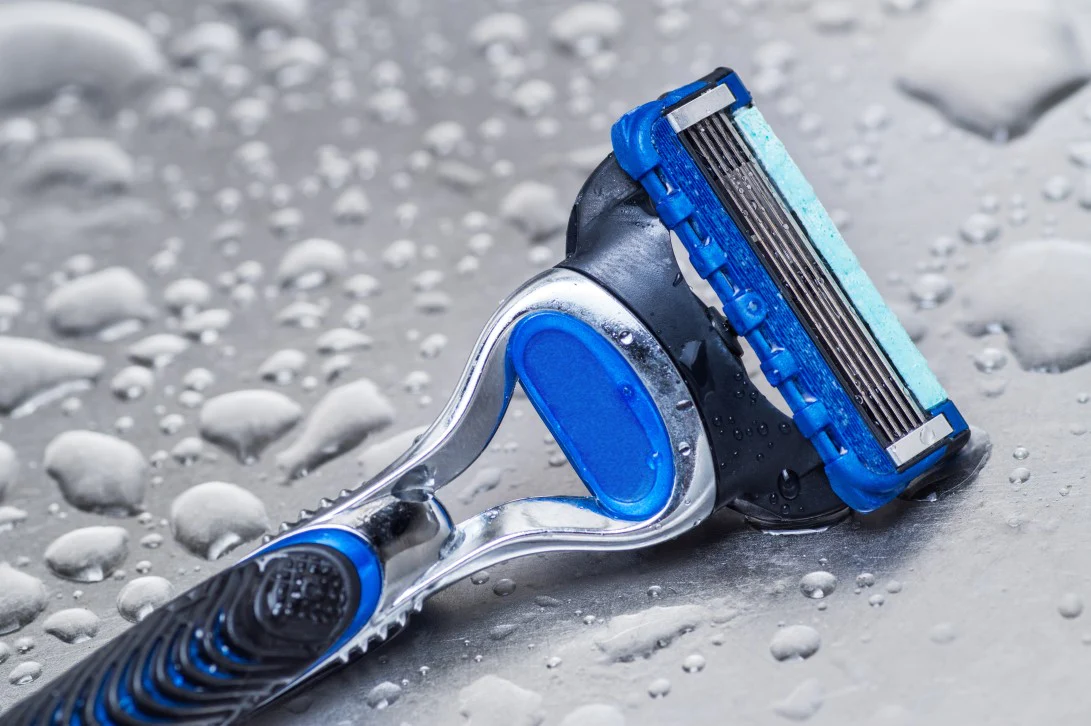
There are electric razors, which use rotating or oscillating blades and don’t require shaving cream or gel. Regardless of the type, razors are essential grooming tools for both men and women, ensuring a clean and well-groomed appearance.
Structure of Razor
A Razor is a tool designed primarily for shaving hair close to the skin. While there are various types of razors, they all share certain structural elements. Here’s a general breakdown of the structure of a typical razor:
- Handle: The part that users grip. Depending on the razor type, it can be made from various materials, including plastic, metal, or wood.
- Head: The top part of the razor where the blade is mounted. It’s designed to hold the blade at the optimal angle for shaving.
- Blade(s): The sharp element responsible for cutting the hair. Depending on the type of razor, there might be a single blade or multiple blades arranged in parallel.
- Guard: A protective feature in many razors, especially safety razors, which ensures the blade doesn’t cut too close to the skin, minimizing the risk of cuts.
- Lubricating Strip: Found on many modern cartridge razors, this is a strip located above or below the blade(s) that releases lubricants during shaving to reduce friction and provide a smoother glide.
- Pivot Point: Present in many cartridge razors, this allows the head to pivot or flex, adjusting to the contours of the face or body for a closer shave.
- Locking Mechanism: For razors that allow blade replacement, like cartridge or safety razors, there’s typically a mechanism to secure the blade in place safely.
- Hinge: In some folding straight razors (also known as “cut-throat” razors), there’s a hinge that allows the blade to fold into the handle.
- Blade Exposure: The amount of blade that is exposed and interacts with the skin. This can affect the aggressiveness of the shave.
- Comb (Optional): Found in some safety razors, this is a series of ridges at the base of the head to help guide hair towards the blade and provide some level of skin protection.
Depending on the type of razor (e.g., straight razor, safety razor, cartridge razor, disposable razor, or electric razor), the structure can vary, and not all elements may be present. Each type of razor is designed with specific features to suit various shaving preferences and needs.
Benefits of Razors
Razors have been used for centuries as primary tools for shaving and achieving a smooth skin surface. Here are some of the main benefits of using razors:
- Close Shave: Razors, especially safety and straight razors, provide a very close shave, removing hair right at the skin’s surface for a smooth finish.
- Precision: Razors allow for precise edging, making them ideal for defining facial hair borders, sideburns, and other detailed grooming tasks.
- Quick Results: A razor can quickly achieve a clean-shaven look without the need for multiple passes, especially with multi-blade cartridge razors.
- Versatility: Razors can be used on various parts of the body, from the face to the legs, underarms, and more.
- Cost: While there’s a range of razor types with varying costs, basic safety razors and disposable razors can be relatively affordable.
- Simplicity: Razors have a simple design and are easy to use, making them accessible for everyone, even those new to shaving.
- Portability: Razors are compact and lightweight, making them convenient for travel or on-the-go grooming.
- Variety: There’s a wide variety of razors available, from traditional straight razors to modern multi-blade cartridge razors and electric razors, catering to individual preferences.
- Reduced Hair Growth: Over time, regular shaving can sometimes make hair appear finer, although this effect can vary among individuals.
- Exfoliation: Shaving with a razor also helps exfoliate the skin by removing dead skin cells from the surface, leading to a fresher and brighter skin appearance.
- Aesthetics: Many people prefer the clean-shaven look, which can only be achieved with a razor, especially for special occasions or specific professions.
- Feel: The sensation of smooth skin after a razor shave is preferred by many, both for personal comfort and tactile enjoyment by partners.
It’s essential to use razors correctly, with proper preparation (like using shaving cream or gel) and aftercare (like using aftershave) to prevent skin irritation, nicks, and cuts. Proper maintenance, including regular blade changes, ensures a safe and effective shave.
Drawbacks of Razors
While razors are popular tools for achieving a smooth shave, they also have their own set of drawbacks:
- Skin Irritation: Razors, especially when used improperly, can lead to skin irritation, redness, or razor burn.
- Risk of Cuts: There’s a higher risk of getting nicks and cuts, especially with straight razors or if used hastily.
- Ingrown Hairs: Shaving too close to the skin can sometimes cause ingrown hairs, which can be painful and lead to inflammation.
- Frequent Replacement: Disposable razors and cartridges wear out and need frequent replacement, which can be costly over time.
- Environmental Concern: Disposable razors contribute to plastic waste. Even cartridge systems, where only the blade head is replaced, generate more waste than straight or safety razors.
- Maintenance: Straight razors require regular honing and stropping to maintain their sharpness.
- Learning Curve: There’s a learning curve, especially with straight and safety razors, to achieve a safe and effective shave.
- Time-Consuming: A thorough shave, especially with traditional razors, can be more time-consuming than a quick trim.
- Blade Dullness: Dull blades can cause tugging and pulling of hair, leading to discomfort. It’s essential to replace or sharpen blades regularly.
- Aesthetic Limitations: Razors are primarily for clean shaving, so if you want to maintain some hair length or specific styles, they may not be the ideal choice.
- Storage: Wet razors need proper storage to prevent blade rust and prolong their lifespan.
- Cost: While some razors might seem cheap initially, the recurring cost of replacement blades or cartridges can add up over time.
- Hygiene Concerns: Blades need to be cleaned properly to prevent bacterial growth, which can lead to skin infections if neglected.
Despite these drawbacks, many people prefer razors for the smooth finish they provide. Choosing the right type of razor, using quality shaving products, and adopting proper shaving techniques can help mitigate many of these concerns.
Comparison table of Trimmer and Razor
Here’s a comparison table of Trimmers and Razors:
| Feature | Trimmer | Razor |
|---|---|---|
| Purpose | Designed to cut, shape, and trim facial hair to various lengths. | Provides a close shave, removing hair from the skin surface. |
| Precision | Offers multiple settings to decide the length of facial hair. | Gives a clean, close finish without length settings. |
| Safety | Less risk of cuts and nicks due to protective guards. | Higher risk of cuts and nicks, especially for beginners. |
| Maintenance | Requires regular cleaning and occasional blade replacements. | Manual razors require blade changes; electric ones need occasional cleaning. |
| Portability | Bulky, especially those with multiple attachments. | Typically lighter and more compact, especially disposable ones. |
| Cost | Initial cost is generally higher, but long-term can be cost-effective due to fewer blade replacements. | Manual razors can be cheaper initially, but blade replacements add up. Electric razors can be pricier. |
| Versatility | Can achieve various looks from stubble to a full beard. | Primarily for a clean-shaven look. |
| Skin Health | Less direct contact with the skin can mean fewer irritations. | Direct contact can lead to razor burns or ingrown hairs for some. |
| Battery/Power | Most modern trimmers are battery-powered or rechargeable. | Manual razors don’t require power; electric razors can be battery-powered or rechargeable. |
| Attachments/Accessories | Often come with multiple attachments for different lengths and areas. | Generally come as standalone, though some electric razors have pop-up trimmers. |
The features and descriptions in this table provide a general overview. Actual attributes can vary based on specific brands and models.
Cost Implications
The cost implications associated with trimmers and razors vary based on multiple factors such as initial investment, maintenance, and long-term usage. Let’s break down the costs associated with each:
Trimmers:
- Initial Investment: Good quality trimmers can range from moderately priced to expensive, depending on brand, features, and attachments included.
- Maintenance Costs: Over time, you might need to replace blades or purchase lubricating oil. Though, these costs are typically infrequent.
- Power/Battery Costs: Battery-operated trimmers will either require battery replacements or electricity costs for charging.
- Longevity: High-quality trimmers can last several years, making the long-term cost potentially lower than it might seem initially.
Razors:
- Initial Investment:
- Disposable Razors: Cheap initially but are meant for short-term use.
- Cartridge Razors: The handle can be moderately priced, but replacement cartridges can be costly over time.
- Safety Razors: A one-time investment in a good handle can be more expensive initially, but replacement blades are very cheap.
- Straight Razors: Expensive initially but can last a lifetime with proper care.
- Maintenance Costs:
- Cartridge Razors: Regular replacement of cartridges is where the cost adds up.
- Safety Razors: Blades are cheap to replace but need changing more frequently than cartridges.
- Straight Razors: Require honing and stropping tools, but no blade replacements.
- Longevity: With proper care, safety and straight razors can last years to a lifetime, potentially offering savings in the long run.
- Shaving Products: Regardless of the razor type, you’ll likely invest in shaving creams, soaps, brushes, and aftershaves, adding to the overall cost.
Cost-Benefit Analysis:
- Short-Term vs. Long-Term: While disposable or cartridge razors might seem cost-effective in the short term, safety or straight razors can be more economical over several years, despite a higher initial investment.
- Frequency of Use: How often you shave or trim can significantly influence costs. Daily shavers might find cartridge razors more expensive in the long run compared to safety razors.
- Versatility vs. Specialization: Trimmers can be used for various grooming tasks (like beard trimming, haircuts, body grooming), potentially saving costs on separate tools. Razors are specialized for shaving.
The best choice from a cost perspective depends on your grooming habits, desired investment, and how you value upfront costs versus ongoing expenses. Both tools can be cost-effective in different scenarios and for different users.
Making the Right Choice for You
Choosing between a trimmer and a razor — or determining whether you need both — is a personal decision based on your grooming preferences, lifestyle, and specific needs.
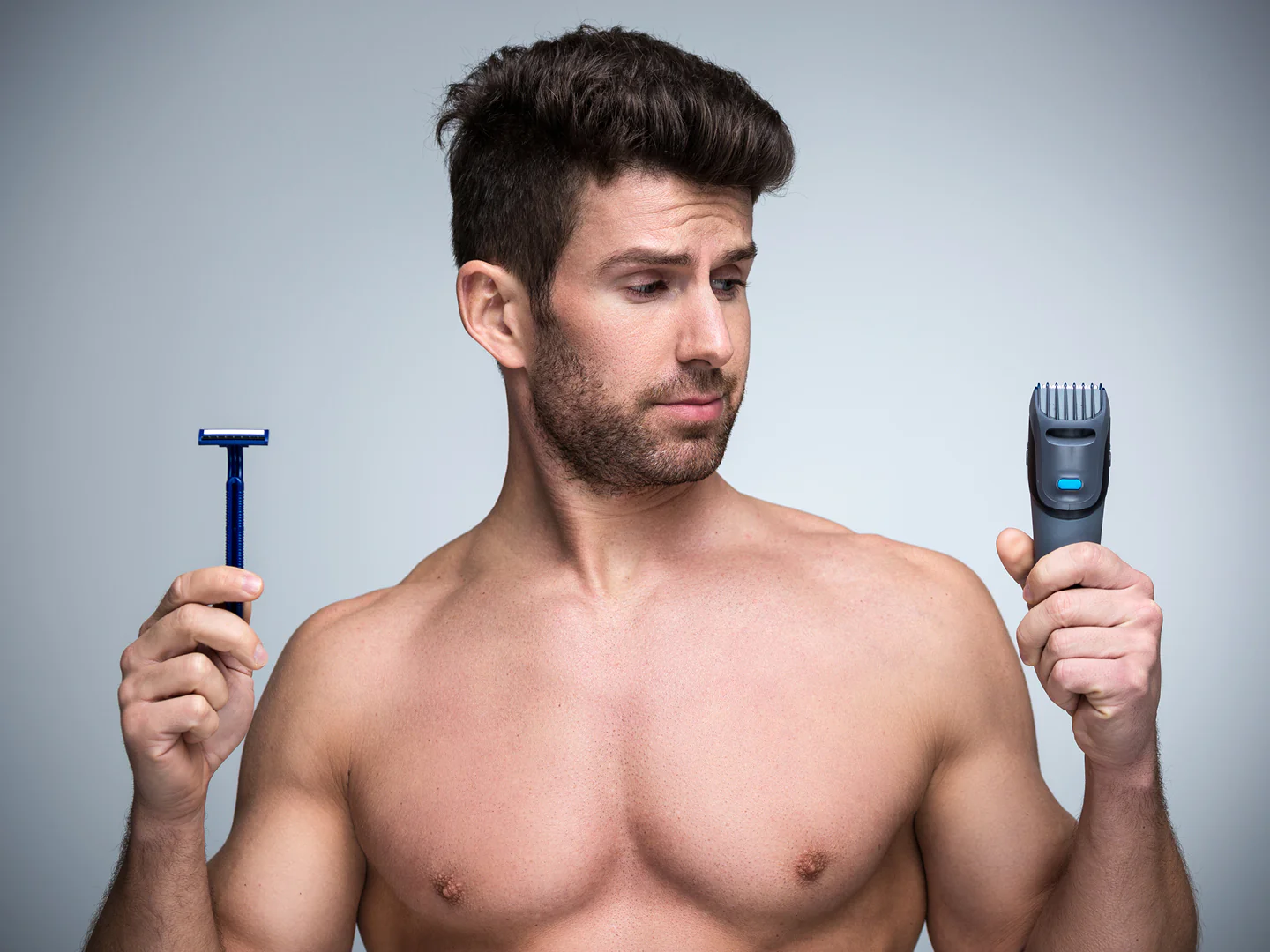
Here are some considerations to help you make an informed choice:
- Desired Look:
- If you prefer a completely smooth, clean-shaven appearance, a razor is the way to go.
- For maintaining stubble, shaping beards, or cutting hair to a specific length, a trimmer is more suitable.
- Skin Sensitivity:
- If you have sensitive skin prone to irritation, cuts, or razor burns, a trimmer might be less harsh on your skin.
- Convenience & Time:
- For quick grooming sessions, especially on-the-go, trimmers can be faster and more convenient.
- For a close shave, especially with traditional razors, you might need more time and preparation.
- Cost & Maintenance:
- Consider the long-term costs of regularly replacing razor blades or cartridges versus the potential one-time investment in a good trimmer.
- Maintenance, like honing a straight razor or cleaning a trimmer, is also a factor.
- Versatility:
- If you often change your facial hair style or length, a trimmer with various attachments and length settings offers more versatility.
- Razors are primarily for achieving a clean shave.
- Environmental Impact:
- If sustainability is a concern, consider the environmental impact of disposable razors and cartridges versus an electric trimmer.
- Travel & Portability:
- For frequent travelers, the size, battery life, and voltage adaptability of trimmers might be crucial.
- Safety razors or disposable razors might be more travel-friendly due to their compact size.
- Learning Curve:
- Traditional razors, especially straight razors, have a steeper learning curve compared to cartridge razors or trimmers.
- Hygiene & Health:
- Consider any skin conditions, allergies, or hygiene preferences that might make one tool more suitable than the other.
- Aesthetics & Experience:
- Some people enjoy the ritual of traditional wet shaving with a safety or straight razor, while others might prioritize the functionality and speed of electric trimmers.
It’s essential to assess your priorities and try out different tools to see which aligns best with your needs. Some individuals find value in having both a razor and a trimmer in their grooming arsenal, utilizing each tool for specific purposes.
Final Opinion
Trimmers and Razors are fundamental grooming tools, each catering to specific needs. While trimmers offer versatility in styling and are ideal for those who prefer maintaining length or crafting detailed beard designs, they don’t provide the ultra-smooth finish that razors do. Razors, on the other hand, excel in delivering a close shave, epitomizing the clean-shaven look, but require more precision and care in use to avoid skin irritations and cuts.
The choice between them hinges on one’s grooming preferences, desired outcomes, and the level of maintenance and skill one is comfortable with. For many, a combination of both tools ensures a comprehensive grooming experience.

